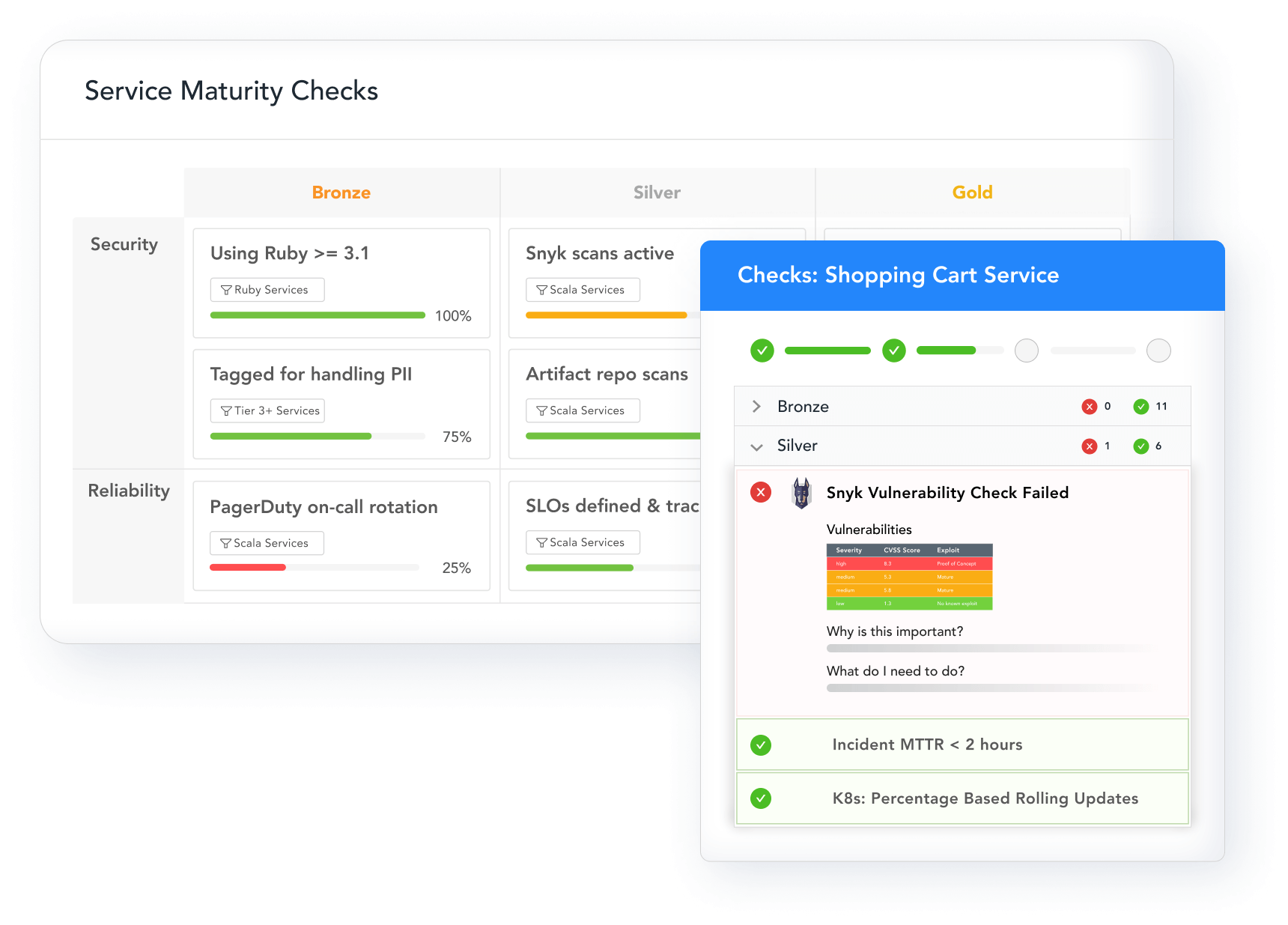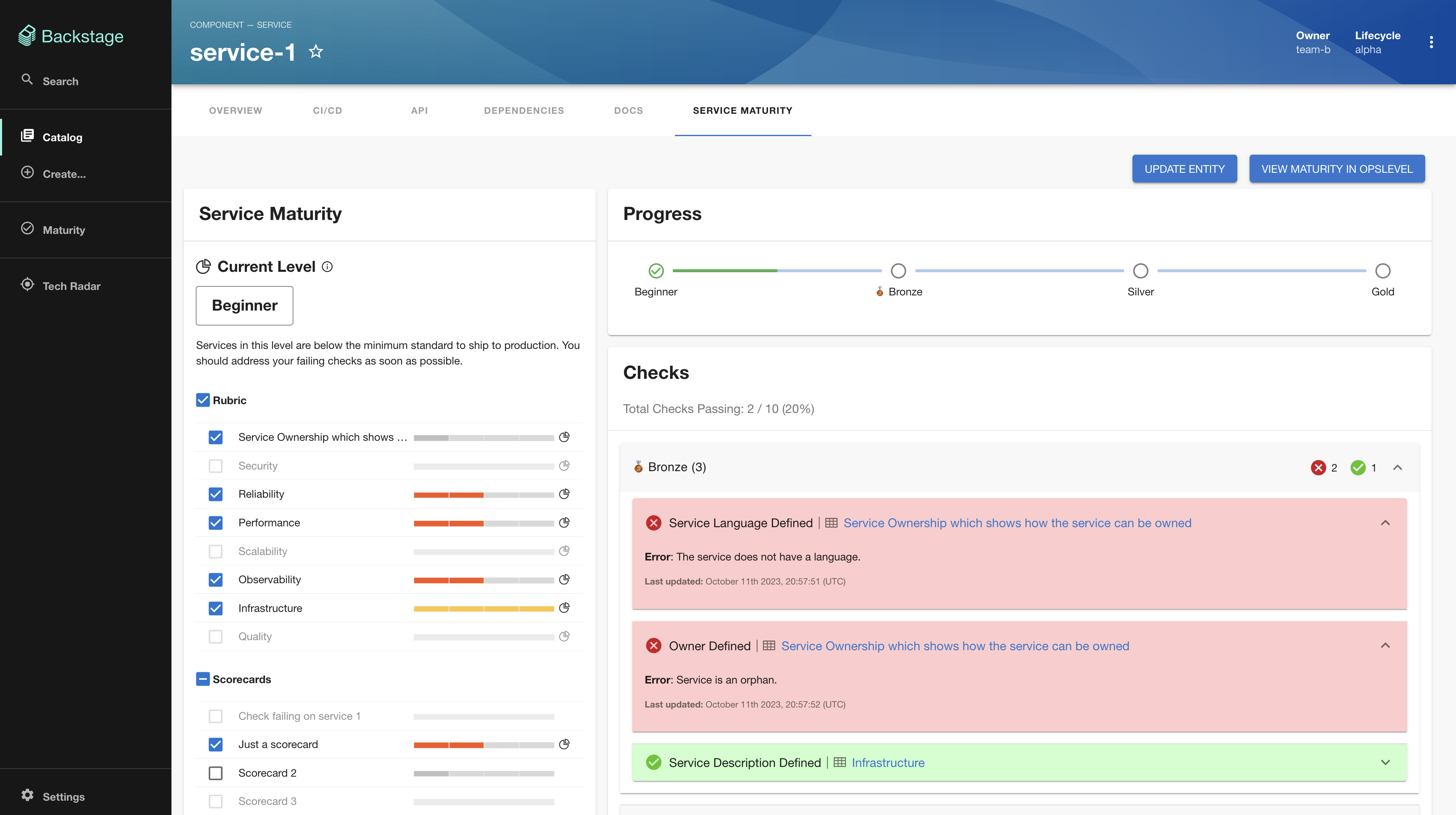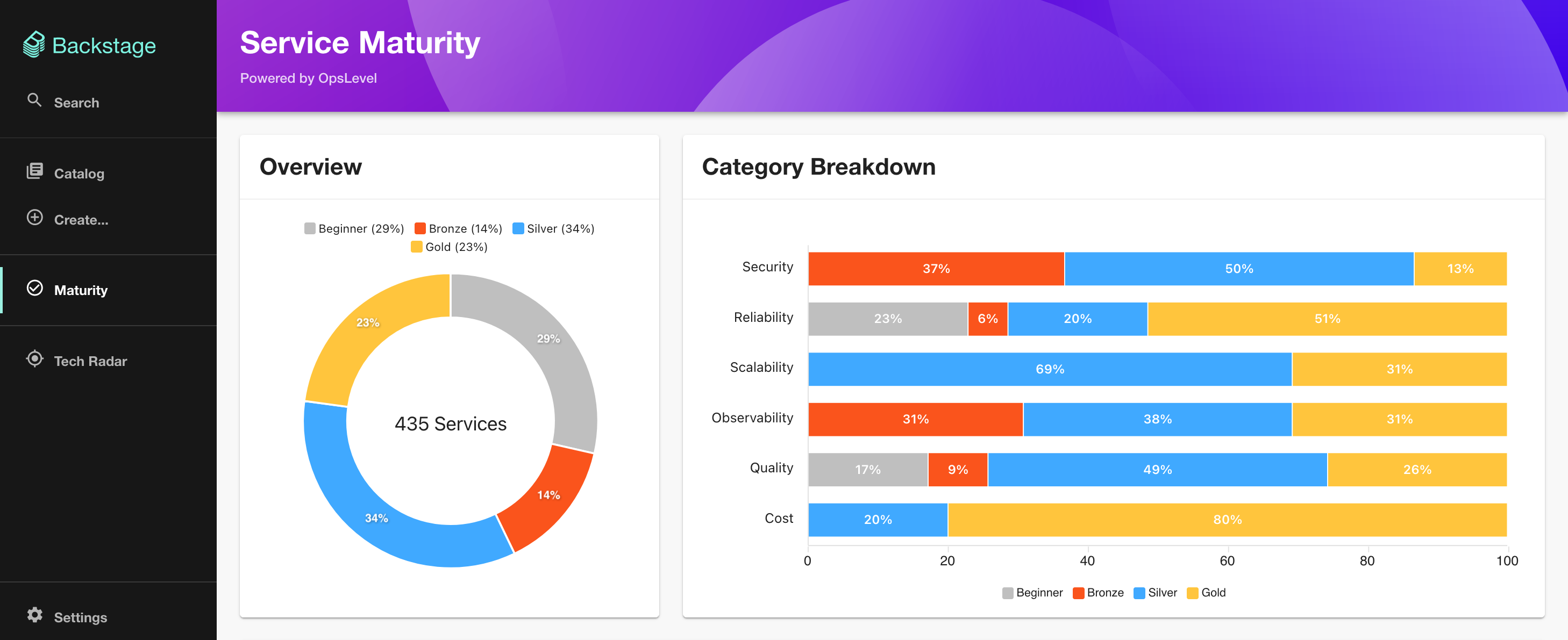@opslevel/backstage-maturity v3.0.1
OpsLevel Maturity Plugin
This plugin helps you leverage OpsLevel's powerful maturity features with your existing Backstage catalog. An OpsLevel API Key is required to use this plugin.



OpsLevel gives platform engineers and DevOps leaders the tools to drive service maturity for their teams. We understand that maturity features alongside your software catalog are critical to a culture of service ownership. Which is why we’ve made our maturity features available to Backstage users within their existing service catalog.
OpsLevel uses Checks to measure Service Maturity. Checks let you explicitly define how you want your services to be built and operated. With OpsLevel Checks, you can verify that services:
- Are using a particular version of a library or framework
- Have migrated to a new third-party tool (e.g., all services use Splunk)
- Meet certain operational requirements (e.g., all Tier-1 services have an on-call schedule)
And a whole lot more.
Paired with our Rubric, Checks allow you to get a holistic view of the health of your software ecosystem. This allows you to not just catalog and create new services but also take action to prevent outages and vulnerabilities.
With the plugin, you can view maturity progress in context with the rest of your service information in Backstage. If you want to dig deeper, you can toggle back to OpsLevel from Backstage to see more health metrics through our Rubric or Check Reports.
Note: Due to the current configuration of API Tokens in OpsLevel, Backstage needs administrator permissions to retrieve all account data. We recommend strongly to only use this plugin if your Backstage instance is exposed only to internal users via VPN.
Install Plugin
yarn add --cwd packages/app @opslevel/backstage-maturitySetting up this plugin requires the following changes to the app-config.yaml file:
Set Up Proxy Configuration
Add a proxy configuration for OpsLevel. Replace <your_OpsLevel_API_token> with a token from https://app.opslevel.com/api_tokens (or, if you're running a self-hosted OpsLevel instance, the /api_tokens page on your OpsLevel instance).
proxy:
endpoints:
'/opslevel':
target: 'https://app.opslevel.com'
credentials: 'dangerously-allow-unauthenticated'
headers:
X-Custom-Source: backstage
Authorization: Bearer <your_OpsLevel_API_token>
allowedHeaders: ['GraphQL-Visibility']If you're running Self-Hosted OpsLevel, replace target with your URL.
:warning: If you are using an authentication solution with Backstage: Ensure that it does not interfere with the HTTP headers going through this proxy. If requests to OpsLevel seemingly inexplicably fail with a HTTP 401 (Unauthorized) response, but you have confirmed that your API token is valid, this is one possible root cause. Due to the customizable nature of Backstage, the support we will be able to offer in such cases will be limited.
Set Up the Base OpsLevel URL
opslevel:
baseUrl: 'https://app.opslevel.com'If you're running Self-Hosted OpsLevel, replace baseUrl with your URL.
Add Route & Global nav
Update packages/app/src/App.tsx
import { OpslevelMaturityPage } from '@opslevel/backstage-maturity'; <Route path="/opslevel-maturity" element={<OpslevelMaturityPage />}/>Update packages/app/src/components/Root/Root.tsx
import CheckCircleOutlineIcon from '@material-ui/icons/CheckCircleOutline'; <SidebarItem
icon={CheckCircleOutlineIcon}
to="opslevel-maturity"
text="Maturity"
/>Add Tab for Maturity to Services
In packages/app/src/components/catalog/EntityPage.tsx import the plugin and add it to serviceEntityPage
import { EntityOpsLevelMaturityContent } from '@opslevel/backstage-maturity'; <EntityLayout.Route path="/maturity" title="Service Maturity">
<EntityOpsLevelMaturityContent />
</EntityLayout.Route>Next Steps
Visit the Maturity tab in Backstage to get started. Once you have synced data from Backstage to OpsLevel, you will likely want to set up auto-syncing of data using the backend-plugin.
Troubleshooting
403 API Requests
Please validate that you do not have any middleware set up in Backstage that could be removing headers from the request by the Backstage proxy.
404 API Requests
If you are receiving 404s or any non-200 response codes, it is possible that there is a network firewall preventing Backstage from accessing the OpsLevel instance.
You can rule this out by using Postman or another tool to simulate the request from the machine running Backstage.
Sometimes it can be hard to set up a tool in environments running Backstage, in which was you can use curl to make the request with your API token.
You will need:
[[api_token]]- created from the api token page. It should look likeJEgofP1igAiemSBZ6BJmFma0P8k4FCnIh9sm.
curl 'https://app.opslevel.com/graphql' -X POST -H 'content-type: application/json' -H 'graphql-visibility: internal' -H "Authorization: Bearer [[api_token]]" --data-raw '{"operationName":"requestApplicationConfigs","variables":{},"query":"query requestApplicationConfigs {\n elasticsearchEnabled\n environment\n}"}'If this responds with a successful response, it means that the connection is available and that your token is valid. A successful response looks like:
{
"data": {
"elasticsearchEnabled":true,
"environment":"production"
}
}
